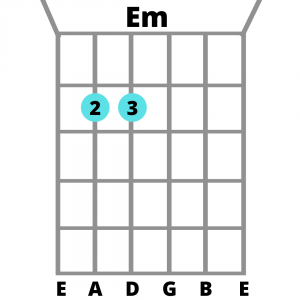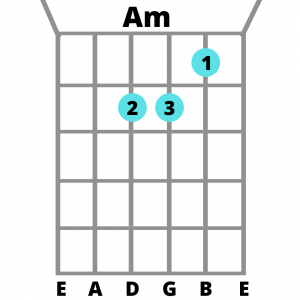
11 Best Online Guitar Courses Reviewed And Compared
What are the best online guitar courses? And how they can help you to learn the guitar? Read all you need to know about online guitar lessons and learning the guitar on your own.

If you are a beginner and want to know how to learn a song on the guitar, you are in the right place. In this article, you will learn how to play simple songs without going crazy. It looks simple: you press the strings on the fretboard with one hand and strike the strings with the other, but the reality is often different.
Many expect results after just a few days, and when the progress doesn’t arrive, they are frustrated. That’s why it’s a good idea to set realistic goals in the beginning. Don’t get me wrong, playing the guitar is not atomic physics, but it also takes your effort and time. If you follow the steps and are patient, you can play your favorite songs in just a few weeks.
The first phase will be to learn the shapes of basic chords. As you probably know, these can be major or minor. The difference between them is what third they contain. The first chord of most guitarists is Em, as you only press 2 strings in the second position as shown.
First, grab the chord with your left hand. Then play all the strings at once with your right hand and then one by one. If some of them don’t sound, it’s because your left hand mutes it or you’re not squeezing the strings enough.


Practicing just one chord won’t keep you entertained for a long time, so we’ll add another: Am. It has a simple shape where you press the strings E, H, and G, while the others are free. Repeat what you have already learned.
Prepare the position of the chord in the left hand and play all the strings first with the right hand and then each one separately. The goal is for each of them to sound good, without muffling or noises. After the time when both chords sound, try to change them. It will take a while to get used to shifting your hand from one to the other, but try to be patient.
Gradually, you can similarly practice other chords in the basic position. Together with those you already know, these are C, D, Dm, E, Em, G, A, Ami. Add them gradually and focus on making all the strings sound to you after shuffling the chords. We have deliberately omitted F and H for now, as these barre chords are more difficult to play.
TIP: Before you start playing chords, it’s good to study how they work and what the relationships are between them. It’s important that you understand what you’re playing and not just mechanically play by chord marks.
Your first song should be one that contains 2, 3, a maximum of 4 basic chords (without F and B). There are many examples, here are just a few suggestions:
You should be familiar with the selected song before you start playing it. Google can help you find chords with text, while on Youtube you can find the original version. Play it and look at the lyrics with chords, without a guitar yet. Notice where the chords change, and what the tempo of the song is.
You can learn to press the strings in the right place relatively quickly. However, playing the rhythm accompaniment with the right hand is a challenge. Most beginners brake at this stage. The principle of playing with your right hand is that you repeat the movement up and down at regular intervals. Sometimes you hit the strings and sometimes not, which creates a rhythmic pattern. These patterns are different in the songs and depend on the tempo and arrangement. However, you can watch the basic ones here:
The next phase is a combination of pressing the chords in the left hand and strumming in the right hand. It often takes many months for both hands to coordinate. The goal is to keep the tempo and sound without breaks.
Rhythm is often the stumbling block for most beginners as well as intermediate guitarists. Therefore, you should make friends with the metronome and use it in exercise. Set a slow tempo (a little slower than you think) and try playing chords without a background track.
Concentrate so that each chord does not sound too early or too late. If you hear progress at a slow pace, try to accelerate slowly. When you feel that you can do it, play the selected song, and try to play with it.
As I said, it will take some time for your backing guitar to play as it should. Remember to look at the chords before each song and play it many times to get it in your ears. Then try playing chords from the song with only a metronome at a slow tempo.
The final stage is to play with the recording so that it fits rhythmically and harmoniously. The ideal scenario is when you play and exercise regularly several times a week. You will gain a habit that will help you make gradual progress and enjoy what you have learned.
If you know after a few weeks how to play a song on the guitar, congratulations 🙂 It’s the first step to playing other songs and improving your technique. Everything we’ve said so far is related to the rhythmic background guitar. I think it’s good to start with chords and strumming, because that way you can play real music first.
Other guitar techniques, fingerstyle, soloing and improvisation are other skills that are good to build on some foundation. However, this is a matter of months and years to come. If you are willing to dedicate your time and effort to the guitar, believe me, the music will bring it back to you 🙂
The best way to learn to play the guitar is to take lessons with an instructor. He can show you and explain the details by which, among other things, you avoid repeating mistakes. For beginners who are learning the acoustic guitar, I recommend Jamplay. These are easy-to-follow online guitar courses that explain the basics of playing in a very clear way. Read my Full Jamplay review if you want to know more.
If practicing the guitar seems to take you a long time, your fingers hurt and you don’t see the light at the end of the tunnel, don’t despair. All guitarists went through this feeling, and not once! If you lose motivation or the will to practice, check out these tips on staying motivated as you learn to play the guitar.
I think (not only me) it’s better if you’re learning to play acoustic guitar rather than electric. The reason is that switching from an acoustic guitar to an electric one is much easier than the other way around. Playing an acoustic instrument is more challenging due to the different fretboard, metal strings, and touch, but it is better to get used to it from the beginning.
I hope this article has made it clear to you at least a little about how to learn a song on the guitar. Once you will be able to play easy songs (chords and strumming), you will have a great background for learning more advanced guitar techniques and music. And don’t forget, learning the guitar is a long way, but when you walk a few meters, you will want to get to the end.

What are the best online guitar courses? And how they can help you to learn the guitar? Read all you need to know about online guitar lessons and learning the guitar on your own.

This Guitar Tricks Review 2021 will give you all information you need to know about this learning platform. Are these online guitar courses good for you? How does it work? Read the review and find it out.